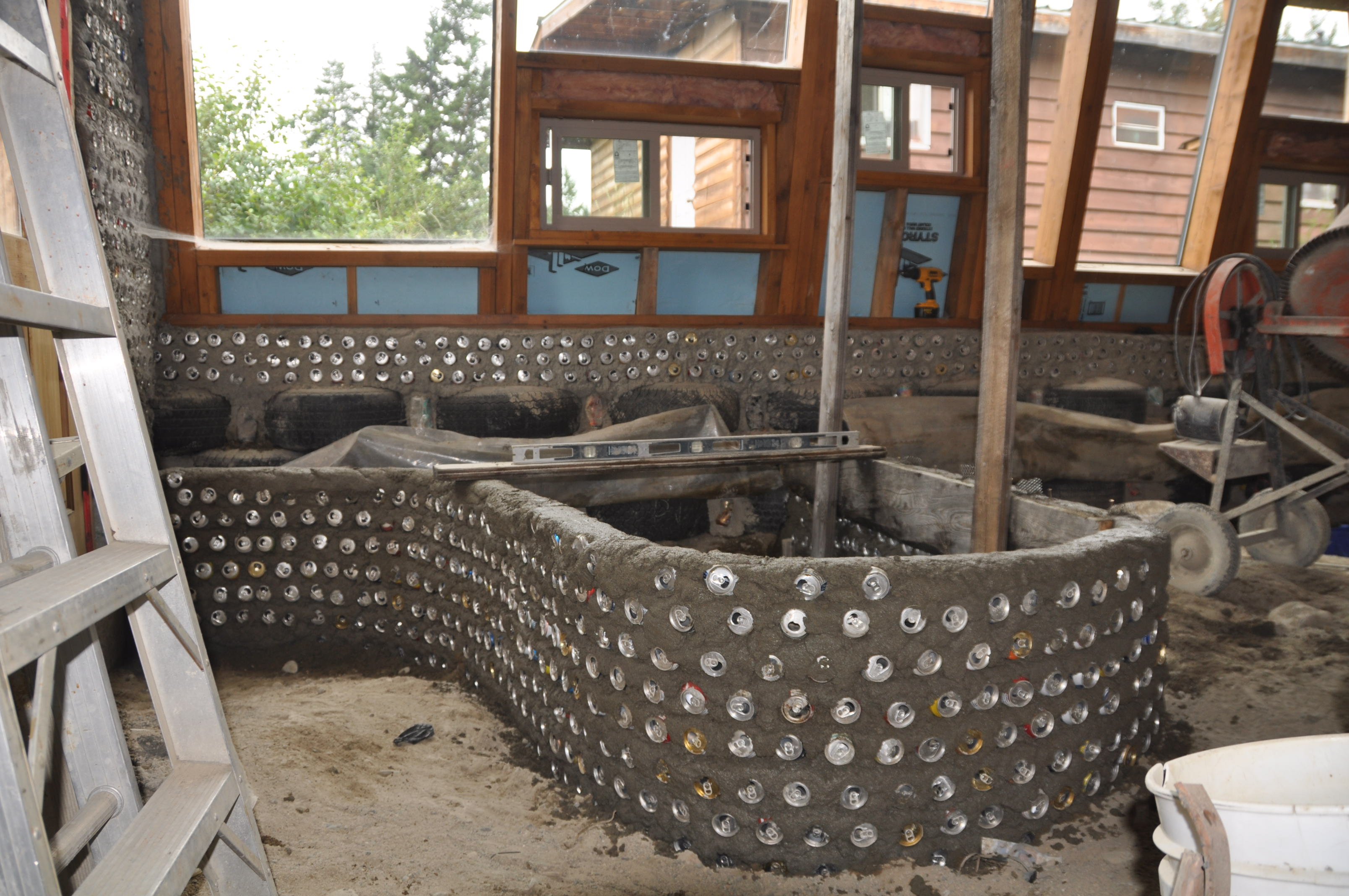
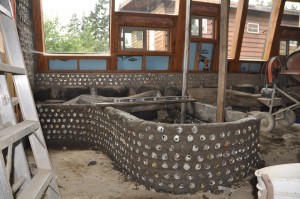 This last week has been challenging; we have been laying out the grey water planters and the bathroom walls along the south face of the earthship.
This last week has been challenging; we have been laying out the grey water planters and the bathroom walls along the south face of the earthship.
The challenge has been laying out the planters and walls while making sure we still have space for kitchen counters, walkways between the rooms and everything that has got to go into the bathrooms. This process has involved a lot of discussion and some arguments. Sandra and I are both still alive so I guess the arguments were not too bad.
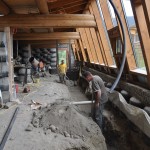
Before laying out the planters we needed to establish a direction of water flow and planter elevation. I did not give a lot of thought to the flow of grey water through the planters when drawing the plans. I did locate the bathrooms along the south face as I felt this would simplify the grey water layout and I think that was a good decision. Our earthship has two bathrooms though, and this means we considered two options for water flow; a split system terminating in the same planter, and a shared linear system. In the split system the kitchen and common bathroom grey water would flow through two shared planters and the bathroom off the master bedroom would flow through its own planter before ending in the same planter as the kitchen and shared bathroom. The split system was my early favourite as it meant short runs from the grey water sources into the planters. I was quickly overwhelmed by the complexity of laying out this system. Not having planned for this idea from the start it was hard to fit our planter layout into a split system. We settled on a linear system that starts at the east and of the building and flows to the west end. This system means some longer runs than I had hoped for, but it is fairly easy to understand and design.
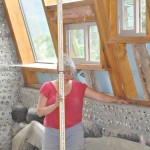 The other consideration in laying out the planters was elevation; both with respect to all the other planters in the system, and in relation to the grey water appliances that are feeding the planters. The appliances feeding the grey water system (sinks, tubs, …) must be elevated above the planters (you need about 1/4″ of elevation per 1′ of horizontal travel of the grey water pipes). In our case it means one to two steps going up into the shared bathroom so that we get sufficient elevation to get the tub water to the start of the planters. Also, each succeeding planter in the system must be slightly lower than the one before it so that water flows through the system (like an underground river instead of a stagnant pond). Again, we sloped the bottoms of the planters approximately 1/4″ per horizontal foot of travel.
The other consideration in laying out the planters was elevation; both with respect to all the other planters in the system, and in relation to the grey water appliances that are feeding the planters. The appliances feeding the grey water system (sinks, tubs, …) must be elevated above the planters (you need about 1/4″ of elevation per 1′ of horizontal travel of the grey water pipes). In our case it means one to two steps going up into the shared bathroom so that we get sufficient elevation to get the tub water to the start of the planters. Also, each succeeding planter in the system must be slightly lower than the one before it so that water flows through the system (like an underground river instead of a stagnant pond). Again, we sloped the bottoms of the planters approximately 1/4″ per horizontal foot of travel.
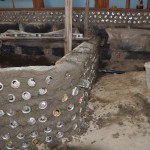 The planters are linked together with pipes located about six inches off of the ‘floor’ of each planter. This means that the 1st planter is connected to the second planter by a 2″ diameter sewage pipe. The pipe leaves the first planter with the bottom of the pipe about 6″ off the floor of that planter and enters the 2nd planter again with its bottom about 6″ off of the floor. This means that the pipe also slopes 1/4″ per foot of horizontal travel to encourage the flow of grey water between the planters. The pipes are located close to the planter bottoms so that the grey water elevation is constant in the system … no one planter is a swamp or dry.
The planters are linked together with pipes located about six inches off of the ‘floor’ of each planter. This means that the 1st planter is connected to the second planter by a 2″ diameter sewage pipe. The pipe leaves the first planter with the bottom of the pipe about 6″ off the floor of that planter and enters the 2nd planter again with its bottom about 6″ off of the floor. This means that the pipe also slopes 1/4″ per foot of horizontal travel to encourage the flow of grey water between the planters. The pipes are located close to the planter bottoms so that the grey water elevation is constant in the system … no one planter is a swamp or dry.
We ran these connector pipes a year ago when we did the initial excavation of our planter space. We used our backhoe to dig a trench along the front of the building. We did not give a lot of thought to the size or elevation of our planters at that time … we just did not want to be hand digging the planters a year later. Our ground is clay and rocks … making it pretty tough digging!
Because we did not set elevations or think through the size of the planters last year we have spent a lot of this week DIGGING BY HAND (I am very glad James is here). We had to re-grade the planter ‘floors’ so that they all consistently slope a 1/4″ per foot, and we had to dig up all of the pipes and set them properly as well. Most of this work is done now except for the last planter on the west side of the building.
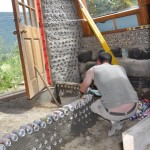 We have also started forming the walls of the planters. Again, the work we did a year ago digging the planters was not very accurate. Most of our initial holes were wider than the intended planters. This means that we have been forming pop can/concrete walls from the bottom of the planters up to our desired planter wall height. Ideally, we would have been able to start the walls on the outside perimeters of the initial excavations, reducing the work and materials required.
We have also started forming the walls of the planters. Again, the work we did a year ago digging the planters was not very accurate. Most of our initial holes were wider than the intended planters. This means that we have been forming pop can/concrete walls from the bottom of the planters up to our desired planter wall height. Ideally, we would have been able to start the walls on the outside perimeters of the initial excavations, reducing the work and materials required.
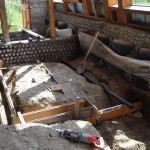 Underneath the pop can walls that form bathroom walls we placed a small concrete footing (6″x6″). Underneath the pop can walls that form planter walls we excavated a small trough and filled the trough with concrete before laying cans. The footings contain engineered fibres and is a standard mix (1 part cement ; 2 parts sand ; 3 parts gravel). None of these walls are load bearing; the purpose of the footing is to create a flat, level working surface for the walls.
Underneath the pop can walls that form bathroom walls we placed a small concrete footing (6″x6″). Underneath the pop can walls that form planter walls we excavated a small trough and filled the trough with concrete before laying cans. The footings contain engineered fibres and is a standard mix (1 part cement ; 2 parts sand ; 3 parts gravel). None of these walls are load bearing; the purpose of the footing is to create a flat, level working surface for the walls.
All in all it has been a productive week!
Regarding the draining into gray water planters, I think you have to expect to see how it drains and modify it, possibly throwing out certain sections until you get it right. It might be good to put a number of cut off valves on branches of the pipe. I’m living in a very old house temporarily. There is no water line coming into the house. I made a practice bottle shower stall and just drain into the yard. I used hose about 3″ in diameter. Flexible hose seems flexible, but when it winds up and down the water tends to stay in the hose here and there unless it’s going downhill sharply. I would try to use straight plastic pipe unless it was at the end of the line.
At first I drilled holes evenly. People complained that it was all coming out near the house.
Of course some people put the kitchen and bathroom(s) back in rooms off the greenhouse face. If gray water drains downhill, it’s going to have to go down to the floor with planters on the floor. That’s an option, but you have to bend over, kid’s stuff might fly in there and it might not get as much sunlight.
Again, I think you have to allow for some kind of adjustment. Most of our gray water comes from the washer. Do we want to drain 30 or 40 liters instantly and suddenly in the planters? Maybe, but some plants could get washed away. We have a pump on our washer drain, so maybe we send the water to a tank with small pipes to let to drain little by little, or allow for adjustment.
Is it worthwhile to have some water drain into some rocks say 3 feet down?
Of course there has to be some overflow to allow it to go outside. Sometimes you may feel you want all of it to go outside. If the bathroom and the kitchen are close to the front center on the greenhouse window, then it’s easier to control all this. I’m not exactly sure how water’s going to overflow outside. I would have to design that in before I ever put the tires in for the front face.
Hi Bob,
You have a number of good observations …
The planters will have flow control such that they can be bypassed via 3 way valves in favour of going directly to the septic field. This is a requirement for the local building authority.
The planters also have overflows leading outside via pipes embedded in the front wall (the pipes were put in when the wall was built). Again, these overflows will run to the septic field or optionally exterior planters (again this is to build them in compliance with the local building authority).
All of the grey water planters will contain 18″-3′ of rock below a layer of dirt. The overflows are located such that the water level cannot rise above the top of the rocks … the water is restricted to the rock layer. The plants will grow in the dirt layer with their roots extending down into the rock layer. Hopefully none of them will get washed away!
The planters will actually be a little higher than they are shown in the pictures. Sunlight striking the planters was a big concern in laying them out. I think we got them high enough to get sufficient sunlight, but we will see how that works out.
The final key to the grey water is re-circulation … the water in the rock layer of the planters needs to be kept moving. We will pump water from the end of the planter chain back to the inlet. We intend to use a DC pump (powered by a solar panel?).
The grey water planters are proving to be one of the largest design challenges in this building … our thoughts on how they will work are constantly evolving!
Chris
I can’t make up my mind how to do it. At first I was thinking: let’s just pour water in bottomless planters. If they fill up and get a bit moist (or aren’t in use), then just re-route that drain somewhere else. Something like the global model has such a small greenhouse. It looks about 6′ wide, but at most half of it has to be hallway, so you’re left with a 2-3′ greenhouse. In the case of the global model it’s on the floor, which seems far from the window and vulnerable to kid’s balls and toys. But still it could be very long.
If you look at the 3BR global model plans, they only have one “first greenhouse” planter behind the inner glass. That one’s in the kitchen near the sink. Did they implement botanical cells in that too? or just dump water in a bottomless planter with rocks deep down? But not all the other rooms with 1st greenhouse glass. If I want to maximize greenhouse, then why not put it there, but then it’s right next to the foundation for the the whole wooden thing holding up the roof (in the global model).
Today I was reading volume 3 where he has the beginnings of the botanical cells called “jungle tanks.” I finally caught the detail that they drew the water up to water the top or send it outside.
My observations are: the botanical cell thing is more expensive than open bottom planters. (FWIW, I’m planning to do a dry toilet, not a flush toilet and don’t want a septic tank.) Let’s say I did open bottom planters, and when they were getting moist, I cut off that drain and sent it outside perhaps to a planter. (There is no building code in Mongolia pretty much.) No one’s offended. I control the water. Even the jungle tanks require manual watering of the top layer.
It seems odd to limit the depth of planters, but then I guess there’s a ceiling in the house too.
If I have the shower and kitchen sink on the front face or near it, let’s say I route water to the top of each planter, but have re-routing valves to send it elsewhere or outside if it seems too wet. I’d have to monitor it from time to time.
With the water running through the bottom to one end, water will pool there. I kind of like the jungle tank idea that you use that water to water the top layer.
You have big/deep planters. Anybody have any advice?
Maybe instead of spending a lot of money on the inner system with the rubber bottoms and pumps, maybe I could build the third greenhouse on front. Then I could send minimal water to the greenhouse in the house and send over half the volume outside to that area.
I’ve never done this before, but it seems very sensible to be able to limit the amount of water going certain spots. If it’s dry, open the valve up all the way. If it’s getting a bit moist or it’s winter, close up that valve partially or entirely and send other water to another spot. Maybe that’s not how drainage works. Maybe that’s asking too much.
Maybe that’s the good thing about the botanical cell/jungle tank. You just send the gray water all to the particle filter, then down to the rocks.
If I took a shower, let’s say I had different drains which function like inputs to various planters (even in 1st greenhouses). (No pump is requires and it just goes downhill, and each planter has overflow pipes.) If I restricted one drain by a valve, then it could begin to fill up another planter. One alternative could be outside. Maybe we just need a distribution system like a D box in a septic system.
If we actually built a monstrosity like a 3rd greenhouse (that thing on the Phoenix rocks, or I have rocks in the head for wanting to build one), we wouldn’t be that concerned about water freezing and just send it out there. Then we would have so much growing space that filling it up might be highly unlikely. It’s just a matter of draining well.
Back to book reading.
If I have an adjustable gray water distributor, I can send proportionate amounts of it to the different planters from a single source. If things are getting too wet, then reduce the load going to that distributor and send some outside.
If a low tech version existed, this would solve the problem and make it unnecessary to channel the water at the bottom through the rocks.
The book, ‘Water From the Sky’ has much more detail on grey water than what is provided in the first three volumes from Earthship Biotecture. The book ‘How to Build A Greywater Oasis’ (?) is also an excellent reference.
I would hesitate to create a ‘bottomless’ planter regardless of applicable building codes as you would then have significant drainage going on under your building … not something you want!
Chris